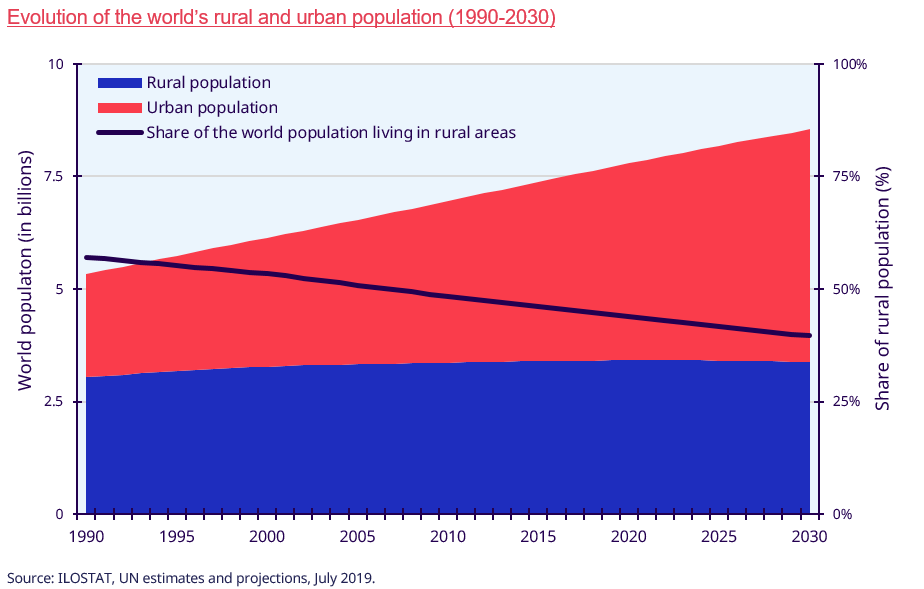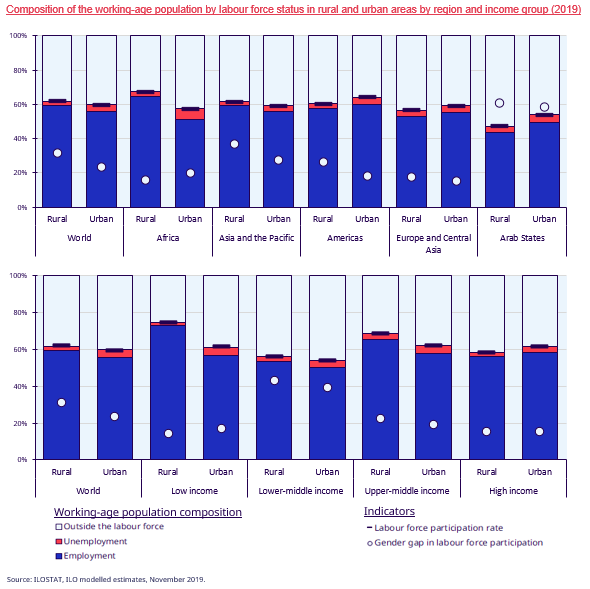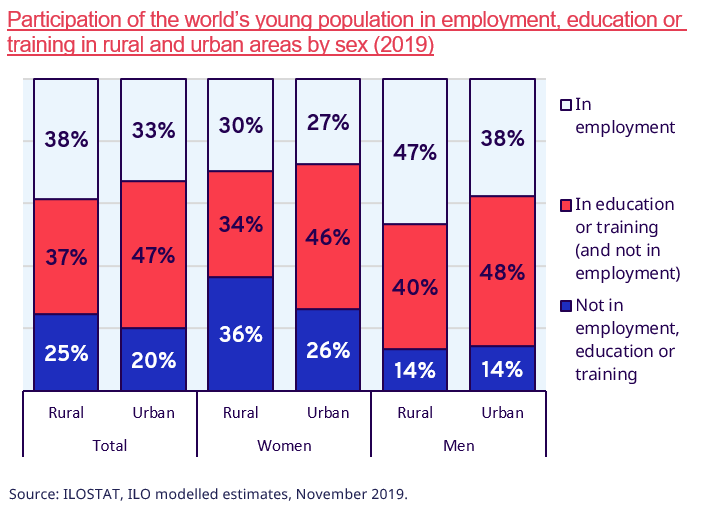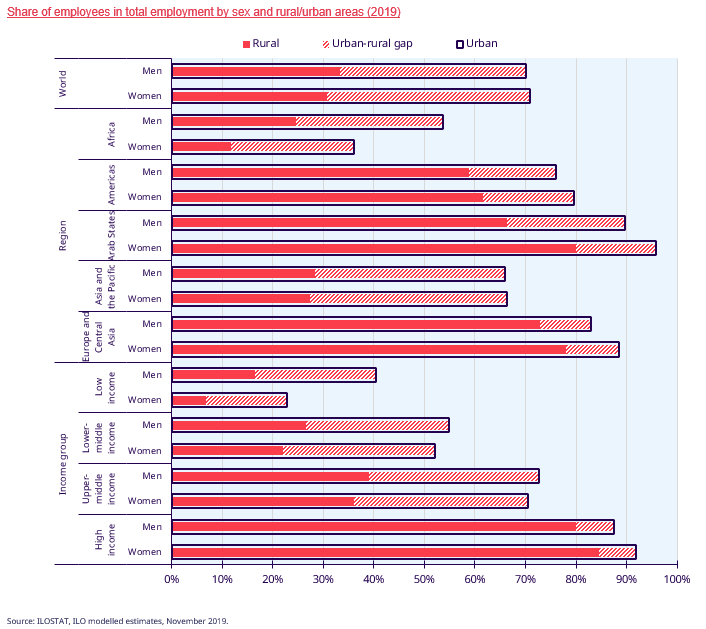Every year on the 15th of October, the world celebrates the International Day of Rural Women, recognizing the critical role of women in rural areas. This day reminds us all of the major contribution of rural women, including indigenous women, to agricultural development, food security and poverty eradication.
Women play a major role in the rural economy as farmers, wage earners and entrepreneurs. They also take responsibility for the well-being of the members of their families, including food provision and care for children and the elderly. Yet, women in rural areas face constraints in engaging in economic activities because of gender-based discrimination and social norms, involvement in unpaid work, and unequal access to education, healthcare, property, and financial and other services. Promoting and ensuring gender equality, and empowering rural women, not only contributes to inclusive and sustainable economic growth, but also enhances the effectiveness of poverty reduction and food security initiatives.
This blog highlights findings from our latest Spotlight on Work Statistics. For more information, check out the full brief.
Urbanization
The world’s population is rapidly increasing, but this growth is far from evenly distributed across geographical areas, with an evident urbanization trend. While in 1990 about 57 per cent of the world’s population lived in rural areas, only 44 per cent of the population remained rural in 2019, and this share is projected to decline to 40 per cent by 2030.
This global urbanization trend has naturally been accompanied by shifts in employment. As urban areas expand and attract more and more people, agricultural activities (typical of rural areas) become less prevalent in terms of persons employed. In line with this, in 1991, 44 per cent of the world’s workers were employed in agriculture, while 34 per cent of them worked in services and 22 per cent in the industrial sector. By 2019, the services sector accounted for half of global employment. While the industrial sector remained fairly stable in terms of the employment share, representing 23 per cent of global employment in 2019, the share of agricultural employment dropped considerably to 27 per cent in 2019.
However, although agriculture is deeply associated with rural areas, not all rural employment is agricultural and not all agricultural activities are located in rural areas. In fact, recent ILO estimates show that 89 per cent of the world’s agricultural employment is based in rural areas, meaning that 11 per cent of agricultural workers in the world live in urban areas. Perhaps more strikingly, only 49 per cent of all workers in the world who live in rural areas work in agriculture, while 10 per cent of them work in manufacturing and 8 per cent of them in construction.
The gender labour force participation gap is wider in rural areas in most regions
In 2019, the world’s rural labour force participation rate was 62 per cent, compared to 60 per cent in urban areas. The labour force participation rate is larger in rural areas than in urban ones in Africa and Asia and the Pacific, while the opposite is true in the Americas, Europe and Central Asia and the Arab States. When it comes to countries’ level of income, people participate in the labour force at higher rates in rural areas in all income groups except for high-income countries.
This could suggest that in more economically developed regions, rural labour markets are less of a driver of employment creation than urban labour markets. In contrast, in less developed economies (and especially in low-income countries), people living in rural areas have a stronger tendency to participate in the labour force, and particularly in employment. Individuals in rural areas may be obliged to take up employment regardless of the characteristics of the job or the working conditions, while in urban areas the jobless may be more able to afford to look for a proper job for longer or to quit the labour force altogether. Persons outside the labour force include (among others) retired persons, students focusing full-time on their education and homemakers. Where informality is more pervasive in rural areas, the corresponding lower social protection coverage and insufficient old-age pensions in rural areas may mean that older individuals are constrained to remain in employment rather than retire. Likewise, the socioeconomic context in rural areas may keep students from devoting themselves exclusively to their education.
Persistent stereotypical gender roles translate into higher labour force participation rates for men than for women in all regions and all income groups around the world. What is more, the gender gap in labour force participation is wider in rural areas than in urban ones in all regions except for Africa, and in all income groups except for low-income countries. This suggests that in most of the world, gendered social norms are more deeply ingrained in rural areas.
Thus, in order to be effective, policies aimed at promoting gender equality in labour markets must take into account the particular circumstances of rural areas.
It is important to note that labour force participation refers to the participation in one specific form of work: employment (paid work done for use by others). This excludes other forms of work, such as subsistence farming, unpaid care work and other types of own-use production work, most commonly done by women and typically prevalent in rural areas.
Labour underutilization takes different shapes in rural and urban areas
By definition, unemployment is labour underutilization, since the unemployed are workers explicitly willing to work and whose labour is not being used. However, there can also be labour underutilization among employed (people in time-related underemployment, that is, working fewer hours than they are available for) or among those outside the labour force (jobless people available for a job although they are not looking for one and those looking for a job although they are not immediately available for it).
Unemployment is the prevalent form of labour underutilization in urban areas: 46 per cent of all people in labour underutilization in the world’s urban areas were unemployed in 2019. In contrast, in rural areas labour underutilization most often takes the form of time-related underemployment, with 46 per cent of all people in labour underutilization in the world’s rural areas being in time-related underemployment in 2019.
Furthermore, there is a gender pattern in the prevalence of different forms of labour underutilization: in rural and urban areas alike, the unemployed represent a larger share of people in labour underutilization among men than among women, while the potential labour force represents a larger share among women than among men. This could point once again to the persistence of stereotypical gendered roles underlying people’s economic and household decisions, such as the decision of which household members should join the labour force and the distribution of household chores and childcare activities. Gendered social norms may lead men to be more available to take up a job and explicitly look for one.
Various factors may explain why labour underutilization takes on different forms in rural and urban areas.
In a sense, unemployment (the act of being jobless but available and looking for a job) is a privilege. Unemployment is an obstacle to decent work and sustainable development, and unemployed people do face hardship. Nevertheless, in some contexts, the possibility of unemployment exists only for those who can afford to be without work, thanks to sufficient unemployment benefits, savings, family support or other means of economic relief.
The prevalence of poverty in rural areas, combined with a lack of appropriate unemployment benefits, social security, or sufficient savings or economic support may mean that rural workers in some contexts cannot afford to remain unemployed for long, resorting to taking up any job available, even if the working conditions are less than desirable. In particular, they may turn to creating their own jobs as own-account workers or contributing family workers, often times in informality, rather than waiting to find an employer. They may also focus more on other forms of work as an alternative to employment (such as own-production work), spending more hours on unpaid work.
All this may contribute to explaining why time-related underemployment is a bigger form of labour underutilization in rural areas than unemployment.
Furthermore, in some rural contexts it may be difficult to actively look for a job if there are no public or private employment services nearby or no generalized access to centralized job advertisement platforms. In such contexts, people may give up the job search out of discouragement although they are still available for employment. Difficulties associated with job searching in rural areas may contribute to explaining why unemployment appears to be more frequent in urban areas.
Youth, and especially young women, face a major labour underutilization challenge which in rural areas adds to difficulties to access education and training
In 2019, young people (aged 15 to 24) living in rural areas around the globe had a labour force participation rate of 43 per cent, compared to 39 per cent for those living in urban areas.
Young people in rural areas have a higher labour force participation rate than those in urban areas in all regions and all income groups. The rural-urban gap in youth labour force participation is particularly striking in Africa and in low-income countries.
It may be that in rural areas, and especially poor rural areas, young people are constrained to joining the labour force earlier on than in urban areas, where they may be more able to devote themselves full-time to higher-level studies or to unpaid trainee work.
Indeed, this is what data on youth participation in employment, education or training in rural and urban areas convey. In 2019, 47 per cent of the world’s urban youth were exclusively in education or training, while that was the case for only 37 per cent of young people living in rural areas. Likewise, the share of young people employed was 38 per cent in rural areas compared to 33 per cent in urban ones. What is more, the share of youth not in employment, education or training was 25 per cent in rural areas compared to 20 per cent in urban ones.
The share of young men not in employment, education or training is virtually the same in rural and urban areas. For young men, the pattern by geographic area seems to be that in urban areas they can participate exclusively in education or training in large numbers, while in rural areas many turn to employment.
Conversely, for young women, it is their share in employment that differs the least in rural and urban areas. In urban areas, young women (just as young men) are able to participate exclusively in education or training in large numbers. However, in rural areas, rather than participating in employment at higher rates, they have a higher tendency to be neither in employment nor in education or training.
This again suggests that gendered social norms remain deeply ingrained in rural areas, where young women may be more likely to participate in unpaid household and care work.
Self-employment in rural areas: the gender pattern behind own-account workers and contributing family workers
Since employees generally benefit from better working conditions, the share of employees in total employment (also known as the paid employment rate) provides a glimpse into the working conditions of the employed population.
Whether workers are located in a rural or an urban area seems to have a great impact on their chances of being in paid employment: in 2019, 70 per cent of the world’s employed living in urban areas were employees, compared to only 32 per cent of those living in rural areas. Indeed, the share of employees in employment was larger in urban areas than in rural ones in all regions and all income groups.
At the same time, the share of own-account workers and the share of contributing family workers are larger in rural areas than in urban ones across the board, with the exception of female workers in low-income countries who have a higher likelihood of being own-account workers in urban areas.
Interestingly, in all regions and all income groups, the difference between rural and urban areas in the share of own-account workers is larger for men than women, and the difference between rural and urban areas in the share of contributing family workers is bigger for women than men. This implies that both male and female workers in rural areas have a low chance of being employees, but men are more likely to occupy jobs as own-account workers while women are more likely to be contributing family workers.
Rural activities in times of pandemic
The world’s agricultural workers, most of whom live in rural areas, have ensured the foundations of the food supply chain with their continued work throughout the pandemic. Given that the vast majority of them are in informal employment, they are in a highly vulnerable situation during the global COVID-19 health crisis. Despite efforts to follow social distancing and hygiene rules in agricultural undertakings, agricultural workers can still be exposed to increased health risks. Meanwhile they rarely have access to sick leave, unemployment benefits or social protection in general, and women farmers are among the least protected.
Moreover, in many countries around the world, agricultural activities rely on seasonal labour migration. Widespread restrictions to international movement are posing an important challenge in this regard, leading to a shortage of labour in some contexts, and a rise in poverty in rural areas.
As the pandemic and the resulting crisis continue to unfold, we are only beginning to see the scope of the damage on both health and socioeconomic outcomes. In this context, it is crucial to closely monitor the evolution in rural and urban areas, particularly as women in rural areas often find themselves in vulnerable situations, so that targeted policies can be effective.
Author
-
Rosina Gammarano
Rosina is a Senior Labour Statistician in the Statistical Standards and Methods Unit of the ILO Department of Statistics. Passionate about addressing inequality and gender issues and using data to cast light on decent work deficits, she is a recurrent author of the ILOSTAT Blog and the Spotlight on Work Statistics. She has previous experience in the Data Production and Analysis Unit of the ILO Department of Statistics and the UN Resident Coordinator’s team in Mexico.
View all posts





